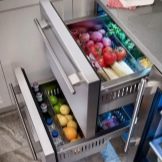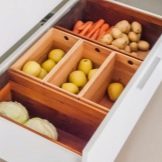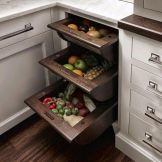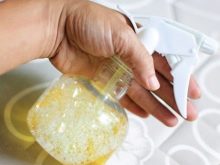Every housewife seeks to ensure the order and safety of things in the house. This is especially true for vegetables and seasonal fruits, which are so valuable in the middle zone. We talk about storage tanks of different types, the rules for their use, significant advantages and individual comparative disadvantages.

Features
Vegetables and fruits are well preserved at home. For storage in the kitchen use:
- container for vegetables or fruits;
- wicker baskets;
- wooden boxes.



The main thing is that these containers have:
- breathable walls
- compact sizes.

In addition to the practical function, storage containers can be a wonderful decoration for your kitchen.
Dimensions and types of construction
There are a huge number of storage systems. Their choice depends only on your preferences and finances.
- Retractable storage systems. In kitchen sets, special metal retractable systems are often found, as well as wicker or plastic baskets that extend. If your headset does not have such systems, you can store fruits and vegetables in plastic, metal, wooden, wicker containers installed in drawers.
- Shelving or whatnot. Stationary or wheeled storage systems, consisting of 6 compartments, in which you can keep both fruits and vegetables. The mobile option is ideal for a small kitchen. In the large kitchen you can install a mobile or stationary wooden whatnot.
- Hanging shelves, containers, baskets located next to or above the countertop. They give the interior coziness of a village house and take up little space.
- Wire or wicker storage baskets. The ideal option is baskets made from natural materials, such as vines. The advantage of such containers is breathability and the absence of large openings, which helps to keep the kitchen clean.
- Special cabinet. You can make it yourself by making special wire windows in an old cabinet, or purchase it in a store. Such a wooden storage is made out in the form of a bench or a stool with a folding seat. The product will take its rightful place in the kitchen, in the corridor or on the balcony.




Materials
Containers are an affordable and practical way to store fruits and vegetables. Similar containers can be from a wide variety of materials.
- Wooden. Strong, but heavy and short-lived. When choosing this type of storage, you need to carefully consider the choice of wood. For example, do not use coniferous boards, since when heated they can release tar and absorb odors.
- Plastic Ease of use and disinfection, strength, durability, moisture resistance, the choice of color and design - all this makes such containers popular.
- Glass. Stylish and safe, but impractical, as it can break when dropped.
- Metal. The most reliable, but there are a number of minuses: high price, not all vegetables and fruits are in good contact with the metal, corrosion, root crops can be damaged on the edge of the container and deteriorate.
- Wicker - from willow vines, rattan, corn fiber. Natural material is great for storage, and will also add comfort and warmth to your kitchen.

Manufacturers Overview
Among the variety of manufacturers can be distinguished three most popular brands in the Russian market of plastic food products.
- "Polymerbyt" - The most famous domestic manufacturer of plastic containers. Produces containers of various volumes, colors, transparent or not. Buyers note the good quality of plastic, durability, original design, multifunctionality, environmental friendliness and "facilitating the existence of the house."

- Branq - The containers of this brand are distinguished by durability, functionality, and practicality. The main thing is to take care of the cover.

- Ikea. This manufacturer is loved for a large number of various stylish containers made of various materials (wood, plastic, metal). In addition to the practical function, these products serve as an excellent decoration of the interior.

How to choose?
Proper packaging is a guarantee of long-term storage of fruits and vegetables. When choosing containers, you need to pay attention to the following points:
- volume (20 l - ideal);
- material;
- breathability;
- ease of use.

Free air access is the most important condition for the storage of root crops: carrots, potatoes, onions, beets. Therefore, when buying, it is important to pay attention to the presence of holes for free air penetration.
Terms of use
The material the container is made of affects where to store vegetables and fruits in the apartment (for example, in the refrigerator or on the balcony).
- Plastic containers - The best choice for storage. They are not afraid of the cold, so vegetables are well preserved on the balcony in winter. The heat of such a container is also not terrible. For convenient use, choose models with handles and a special design that allows you to put containers on top of each other.
- Wooden boxes differ in durability, but it is better to use them for transportation of vegetables and fruits. Such containers are designed for a short period - usually they last only for 1 season with repeated use. For a small extension of life, the boxes can be strengthened with metal inserts, as well as monitor temperature extremes to avoid rotting.
- Cardboard boxes made of eco-material. This is a plus. But still they are short-lived.When using them, you need to pay attention to air humidity, since this factor negatively affects the container (boxes are pressed or bend).

Storage of fruit and vegetable stocks in vegetable stores equipped on the balcony is in great demand. It can be a chest of drawers with sliding shelves, a cabinet with doors or a drawer that resembles a chest with an opening lid. For the convenience of storage in vegetable stores use plastic containers
Care Features
In order for the products to serve for a long time and be safe for storing vegetables and fruits, they must be carefully looked after. There is nothing complicated in leaving. After using the plastic box, immediately wash it with hot water and laundry soap or dishwashing detergent. You can use liquid or toilet soap.

Plastic containers are appreciated for their convenience. Their only disadvantage is the ability to absorb various odors. You can get rid of such trouble with the help of improvised means.
- Soda and vinegar. Pour a thin layer of soda on the damp walls of the container and fill with vinegar. Thanks to such a "pop" all extraneous odors will go away.
- Vinegar. Moisten a tissue with undiluted vinegar and wipe the container from the inside. For disinfection, make vinegar and leave it in the container for several minutes. After that, rinse the plastic container well,
- Soda solution. Pour warm water into the container and pour a little soda. Close the lid and leave for a while. After a little shaking, pour the solution and wipe with a clean cloth soaked in vinegar.
- Lemon. Wipe the inside of the container with a slice of lemon, close the lid and leave overnight. Lemon itself should not be left inside.
- Activated carbon. Wrap the crushed coal tablets in a napkin and put in a container for 24 hours.
- Newspaper. Place crumpled newspaper in a container at night. ?



Wooden cases cannot be stored in damp and unheated rooms. Excessive dryness is also contraindicated for them. Boxes should be kept away from direct sunlight, radiators and room heaters, otherwise this will lead to drying out and cracking. And be sure Avoid bumping as this packaging is easily damaged.

See how to choose the right container for fruits and vegetables in the next video.










